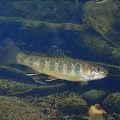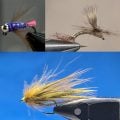Indicator Fishing with Nymphs

Nymphs can be effective in early spring high water. Just make sure you use heavily weighted flies or lots of weight on your leader, and use a high-sticking technique to keep your flies running slow, deep, and drag-free.
When I was a kid, I used to fish a worm hung below a bobber for sunfish and perch. When I first began, like most kids I just threw it out there and waited until the bobber went under and then yanked like hell.
One day I was fishing from a high dock in clear water and was able to watch my worm as it settled under the bobber. I noticed that often the fish would take the worm as it was fluttering down, before it came tight to the bobber, which would make the bobber just twitch or move sideways. Then I noticed that once the worm hung suspended below the bobber, the sunfish were more likely to take it when a boat wake disturbed the bobber, because the worm would twitch seductively as the bobber rocked gently in the waves. After that day I spent more time watching the subtleties of bobber behavior (or as subtle as an eight-year-old can get), and from that day on I tried to imagine what my worm was doing under the surface instead of just watching for the bobber to go under.
In the same way, when we first learn to fish indicators with nymphs, we throw a bobber and a nymph or two out there and strike when the bobber (okay, the indicator) makes a blatant move. We don’t pay much attention to where our rig goes in relation to different current threads, and we don’t really think about what is going on below our indicator. It’s not so much about missing strikes, because it’s best to strike whenever the indicator does anything different than what the bubbles alongside it do. It’s really more about using the indicator as a drift indicator to estimate where your flies are drifting, and in extreme cases when you have a large indicator and a pair of heavily weighted flies or weight on the leader, the indicator becomes a suspension system.
The process begins with the placing of the indicator and flies. Notice I said placing instead of casting, because placing insinuates that you put your rig in a specific location for a reason. But before that, I recommend that you drop your flies into a piece of quiet water right next to you to see how fast they sink. Then figure out where you think a trout might be lying, and cast your flies far enough upstream so that they will be at their maximum depth when they drift past the fish.
How far should that be? There are no simple answers. The faster the water, the farther upstream you need to place your flies. But the current speed changes with every situation and so should the weight on the end of your leader, so this is something you will have to discover empirically. And you will discover this either by catching a fish or catching the bottom. There will be times, later in the season, when your flies will be effective in the middle of the water column or rising toward the surface on a tight line, but at this stage in the season you are best assuming that trout are glued to the bottom and not in a frisky mood.

This is my basic two-indicator rig for most water types. When the yellow indicator gets downstream of or even with the red one, it’s time to mend to avoid drag. The optimum mend will move only the yellow indicator, placing it back upstream of the red one, because that way you only move the leader and line, not the flies.
And even those are not the only variables. If the current where you place your flies has a choppy but uniform flow, with no swirls in it, your flies will sink quicker than if you see a lot of miniature whirlpools that indicate turbulence in all directions. Those sideways swirls of turbulence snatch your tippet and move it sideways and even up, whereas in a nice, steady, uniform flow there is not as much impeding the sink rate of your flies. One of the best ways to ensure that you get a good drift is by using two indicators. Casting is even less fun with two bobbers attached to your leader, but by lining up both indicators, you have an even better indication of whether you’re getting a dead drift or not. When the indicator farthest from your flies moves downstream much quicker than the lower one, you know that you are about to have a problem with drag.
Here is a basic setup for fishing two indicators: Start with a 9-foot knotless tapered nylon leader one X size larger than the tippet you intend to fish. Tie on a piece of tippet to the end of this—I like to begin with between 2 and 5 feet of fluorocarbon, going longer for water over 3 feet deep and shorter for shallower water. Tie a fly onto the end of this tippet, and if you are using two flies, tie the second one to the bend of the first fly with a foot of tippet, either the same size as you tied the first fly or sometimes one size lighter.
In the early season I like to use two flies with tungsten beads, hoping I can get deep enough without adding more weight to my leader. Weight can be added later about 8 inches above the first fly. I like to use tungsten sink putty because it is easy to move, does not usually get hung up, and if it does hang up, it just slips off the leader. It is sometimes hard to keep in place, but you should not be doing any false casting with this rig, so it should stay put at least for a number of casts.
Of course, you can also crimp some split shot to your leader in the same place. It helps to have a knot in the leader to keep the weight from sliding down, but I have mixed feelings about that. I feel that the long fluorocarbon tippet helps sink the flies quickly, so if I use a knot to keep the weight from sliding, it has to be an extra knot in my leader—and knots are always a weak point. If you feel you need a knot, just cut your tippet about 10 inches above the first fly and reattach the tippet with a surgeon’s or blood knot. You just have to balance the annoyance of having the weight slide down to a point where it gets too close to the first fly with the risk of putting another knot into the system.
Now estimate the depth of the water you intend to fish and place your first strike indicator one and a half times the water depth up from your lower fly. Put the second indicator 10 inches above this one. Hopefully the water is not so deep that you have to put your second indicator too close to the fly line. The farther your indicators from the end of the fly line, the easier it is to mend right to the indicator, which is what you should do to get the best drift.
You may be accustomed to using the plastic-bobber-type strike indicators. They are simple to attach, easy to move, and they never sink. They are also not much fun to cast, and they are not a terribly sensitive indicator of either your fly’s drift or a strike. A fish really has to inhale your nymph before they show much movement. On the other hand, yarn casts much nicer, it is far more sensitive, and if the fish are at all spooky, it makes very little disturbance when it lands on the water. True, you have to add paste floatant to it before you start, and when it starts to get waterlogged, it helps to dip the yarn in desiccant powder, but I think these minor annoyances are worth the effort. It also helps to use indicator yarns of two different colors. If light conditions change, one may be more visible than the other, and by using two different colors, you know which indicator is closest to your fly. This becomes important, as you’ll see shortly.

Using two different colors of indicators on your leader gives you an option for spotting one of them when light conditions change, but even more important is that you know where your fly is in relation to the leader, because you know which indicator is closer to your fly.
Cast into a likely spot, and using either a reach cast or a quick mend (or both) as soon as the indicators hit the water, place the second indicator just upstream of the first indicator. As your rig drifts down in the current, the second indicator will move faster than the first because the first is more directly connected to the flies, which drift slower than the indicators because the water below the surface is slower than the water at the surface. So the first indicator will lag a little, and the second indicator will slowly catch up to it. When it gets even with the first indicator, mend again to get that straight-line relationship between the two, and continue this through the drift. By keeping them in a straight line, perpendicular to the current, and not allowing the upper indicator to get downstream of the lower one, you will avoid sliding your fly across currents, which is more important than the flies moving slightly upstream or downstream faster or slower than the current. Natural insects sometimes move slightly faster or slower than the current in the same downstream lane, but they don’t have the power to move across current lanes, which is a more unnatural movement.
The nymph pattern you try in early spring is far less important than getting your nymph in the right place with a dead drift. Some flies will be starting to hatch at this time of year, and it’s always a wise move to try to imitate the insect that is most active at any time of year. The flies you’ll see hatching most often in March and April, size 18 Blue-Winged Olives and scores of different kinds of midges, are small, yet in my experience a larger nymph is just as effective, if not more effective, than the smaller patterns in most rivers.
The last time I was on the Missouri River in April, the water was covered with midges and tiny olive mayflies, and although few fish were rising to the adults, I knew they must be gobbling lots of stuff under the water. I started with a midge pupa, and to get the size 18 nymph down quickly without resorting to weight on the leader, I tied it to a larger size 14
Pheasant Tail nymph with a big tungsten bead to get the little midge down. But I kept catching trout on the much bigger fly. A few took the nymph, but I would say three-quarters of the fish were taken on a fly bigger than anything I saw hatching. I even pumped the stomachs of a couple of fish, and sure enough, they were full of size 18 to 24 midge pupae. But they continued to hammer the bigger fly.
Of course, there are bigger mayflies and caddisflies and stoneflies in the Missouri, and the trout there may see a few of them in the early season when they get dislodged from the bottom or break free during the diurnal drift cycles. You would think the fish would be quicker to recognize what is actively hatching subsurface, but as study after study shows, trout are more opportunistic and less selective than we think, so a larger fly is always a safe bet in early season. Not being much of a betting man, though, I’ll continue to hang a smaller fly off the end of the big one just in case.
Excerpted with permission from “Fly Fishing for Trout: The Next Level” (Stackpole Books, November 2016). All rights reserved.












